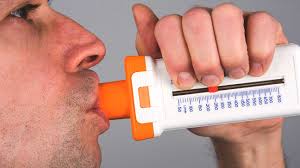Benefits of taking a PEF reading
Peak Expiratory flow (PEF) measurements are simply a measurement of how quickly one can blow air out of the lungs using a simple flow meter. These hand-held flow meters measure air breathed out in litres per minute (l/min) with the measured value displayed on the side of the PEF meter.
Expectations of how much air you can blow using the meter varies based
on age, height
and gender.
Peak expiratory flow measurements can sometimes be used to
diagnose quickly if someone is having an asthma attack. If you are not
breathing in air well into the lungs, there is no way you will be able to
breathe a big volume of air out into the meter. Imagine your usual PEF reading
is around the 500 mark. Recording, say a 300 reading, when the asthmatic
patient is feeling unwell is a sure sign that the asthma condition could be
flaring up and the airways are getting narrow. The user may need to ask for help at this time.
Apart from helping to determine if an asthma attack is taking
place, PEF readings are also a good means of monitoring asthma to determine if one’s
asthma condition
is getting better over time and if the medication is working.
Another good reason why you want to measure your peak expiratory flow is if you are trying to check your vulnerability to an asthma trigger. In this case, a measurement before and after exposure to the possible asthma trigger or allergen can show if there is deterioration in condition after the exposure.
To measure your peak flow:
- find a
comfortable position, either sitting or standing
- reset
your peak flow meter so the pointer is pushed back to the first line of
the scale – this is usually 60
- hold
the peak flow meter so it's horizontal and make sure that your fingers are
not obstructing the measurement scale
- breathe
in as deeply as you can and place your lips tightly around the mouthpiece
- breathe
out as quickly and as hard as you can
- when you've finished breathing out, make a note of your reading
This should be
repeated 3 times, and the highest of the 3 measurements should be recorded as
your peak flow score.
If you're
monitoring your asthma at home, you may have a diary or chart to record your
score. We recommend the use of AsthmApp to record your PEF data.
It is always useful to know your ‘normal’ PEF reading. If you have
asthma and you don’t have a PEF meter at home, please speak to your doctor
about getting a prescription for one or buy off counter when next you are at
the Pharmacy. Once you have one handy, take regular measurements with it to
monitor your health and to have an idea what your normal PEF readings are. And
if your readings are very different from what is normal for you, speak to your
doctor or follow your asthma action plan to take the necessary steps to get
help.





Comments
Post a Comment